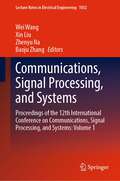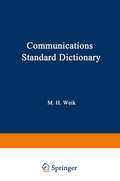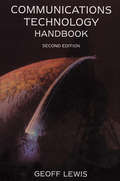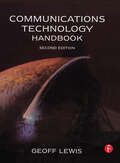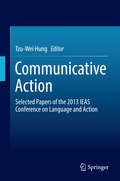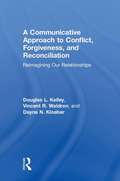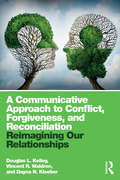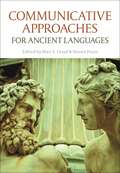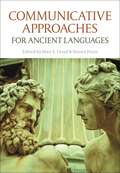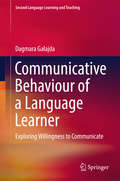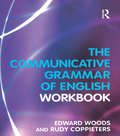- Table View
- List View
Communications, Signal Processing, and Systems: Proceedings Of The 2018 Csps Volume Iii: Systems (Lecture Notes In Electrical Engineering Ser. #517)
by Wei Wang Xin Liu Zhenyu Na Baoju ZhangCommunications Standard Dictionary
by Martin H. WeikCommunications * Standard Dictionary is a comprehensive compilation of terms and definitions used in communications and related fields. Communications is defined as the branch of science and technology concerned with the process of representing, transferring, and interpreting the meaning as signed to data by and among persons, places, or machines. Communication is defined as the transfer of information between a source (trans mitter, light source) and a sink (receiver, photodetector) over one or more chan nels in accordance with a protocol, and in a manner suitable for interpretation or comprehension by the receiver; or as a method or means of conveying informa tion of any kind from one person or place to another. In short, communications is a branch of science and technology, whereas com munication pertains to the actual transfer of information. Thus, the word com munication should be used as a modifier, as in communication center, communi cation deception, and communication line, just as in the field of electronics one speaks of electronic devices and electronic circuits.
Communications Technology Handbook
by Geoff LewisThis is the first point of reference for the communications industries. It offers an introduction to a wide range of topics and concepts encountered in the field of communications technology. Whether you are looking for a simple explanation, or need to go into a subject in more depth, the Communications Technology Handbook provides all the information you need in one single volume.This second edition has been updated to include the latest technology including: Video on DemandWire-less Distribution systemsHigh speed data transmission over telephone linesSmart cards and batteriesGlobal positioning Systems The contents are ordered initially by communications systems. This is followed by an introduction to each topic and goes on to provide more detailed information in alphabetical order. Every section contains an explanation of common terminology, and further references are provided. This approach offers flexible access to information for a variety of readers. Those who know little about communications professionals, the book constitutes a handy reference source and a way of finding out about related technologies. The book addresses an international audience by referring to all systems and standards throughout.This book has been revised to include new sections on: * Video on demand * Wire-less distribution systems * High speed data transmission over telephone lines * Smart cards * Global positioning systems * provides a basic understanding of a wide range of topics* offers a flexible approach for beginners and specialists alike * addresses an international audience by referring to all systems and standards throughout
Communications Technology Handbook
by Geoff LewisThis is the first point of reference for the communications industries. It offers an introduction to a wide range of topics and concepts encountered in the field of communications technology. Whether you are looking for a simple explanation, or need to go into a subject in more depth, the Communications Technology Handbook provides all the information you need in one single volume.This second edition has been updated to include the latest technology including: Video on DemandWire-less Distribution systemsHigh speed data transmission over telephone linesSmart cards and batteriesGlobal positioning Systems The contents are ordered initially by communications systems. This is followed by an introduction to each topic and goes on to provide more detailed information in alphabetical order. Every section contains an explanation of common terminology, and further references are provided. This approach offers flexible access to information for a variety of readers. Those who know little about communications professionals, the book constitutes a handy reference source and a way of finding out about related technologies. The book addresses an international audience by referring to all systems and standards throughout.This book has been revised to include new sections on: * Video on demand * Wire-less distribution systems * High speed data transmission over telephone lines * Smart cards * Global positioning systems * provides a basic understanding of a wide range of topics* offers a flexible approach for beginners and specialists alike * addresses an international audience by referring to all systems and standards throughout
Communicative Action: Selected Papers of the 2013 IEAS Conference on Language and Action
by Tzu-Wei HungThis book focuses on the connection between action and verbal communication, exploring topics such as the mechanisms of language processing, action processing, voluntary and involuntary actions, knowledge of language and assertion. Communication modelling and aspects of communicative actions are considered, along with cognitive requirements for nonverbal and verbal communicative action.Contributions from expert authors are organised into three parts in this book, focussing on language in communication, action and bodily awareness and sensorimotor interaction and language acquisition.Readers will discover various methods that have been employed in investigations presented here, including neurological experiment, computational modeling and logical and philosophical analysis.These diverse expert perspectives shed light on the extent to which a mechanism for processing actions also facilitates the processing of language and the authors’ work prompts further interdisciplinary investigation of the relationship between language and action.This book is written for readers from different academic backgrounds; from graduate students to established academics in disciplines ranging from neuroscience to psychology, philosophy, linguistics and beyond.Earlier versions of the selected essays in this book were presented at the 2013 IEAS Conference on Language and Action, held in Taipei, Taiwan.
A Communicative Approach to Conflict, Forgiveness, and Reconciliation: Reimagining our Relationships
by Douglas L. Kelley Vincent R. Waldron Dayna N. KloeberA Communicative Approach to Conflict, Forgiveness, and Reconciliation: Reimagining Our Relationships synthesizes communication and psychology scholarship that focuses on rebuilding ourselves and our relationships when things go "wrong". It provides fresh insights into the burgeoning body of forgiveness research, with an emphasis on community application and reconciliation. Written by award winning scholars in forgiveness communication, the book makes forgiveness and reconciliation research accessible to students in courses focused on personal relationships, conflict, and family studies.
A Communicative Approach to Conflict, Forgiveness, and Reconciliation: Reimagining Our Relationships (PDF)
by Douglas L. Kelley Vincent R. Waldron Dayna N. KloeberA Communicative Approach to Conflict, Forgiveness, and Reconciliation: Reimagining Our Relationships synthesizes communication and psychology scholarship that focuses on rebuilding ourselves and our relationships when things go "wrong". It provides fresh insights into the burgeoning body of forgiveness research, with an emphasis on community application and reconciliation. Written by award winning scholars in forgiveness communication, the book makes forgiveness and reconciliation research accessible to students in courses focused on personal relationships, conflict, and family studies.
A Communicative Approach to Conflict, Forgiveness, and Reconciliation: Reimagining Our Relationships
by Douglas L. Kelley Vincent R. Waldron Dayna N. KloeberA Communicative Approach to Conflict, Forgiveness, and Reconciliation: Reimagining Our Relationships synthesizes communication and psychology scholarship that focuses on rebuilding ourselves and our relationships when things go "wrong". It provides fresh insights into the burgeoning body of forgiveness research, with an emphasis on community application and reconciliation. Written by award winning scholars in forgiveness communication, the book makes forgiveness and reconciliation research accessible to students in courses focused on personal relationships, conflict, and family studies.
A Communicative Approach to Conflict, Forgiveness, and Reconciliation: Reimagining Our Relationships
by Douglas L. Kelley Vincent R. Waldron Dayna N. KloeberA Communicative Approach to Conflict, Forgiveness, and Reconciliation: Reimagining Our Relationships synthesizes communication and psychology scholarship that focuses on rebuilding ourselves and our relationships when things go "wrong". It provides fresh insights into the burgeoning body of forgiveness research, with an emphasis on community application and reconciliation. Written by award winning scholars in forgiveness communication, the book makes forgiveness and reconciliation research accessible to students in courses focused on personal relationships, conflict, and family studies.
Communicative Approaches for Ancient Languages
by Mair E. Lloyd and Steven HuntThis book is the first in its field. It showcases current and emerging communicative practices in the teaching and learning of ancient languages (Latin and Greek) across contemporary education in the US, the UK, South America and continental Europe. In all these parts of the globe, communicative approaches are increasingly being accepted as showing benefits for learners in school, university and college classrooms, as well as at specialist conferences which allow for total immersion in an ancient language. These approaches are characterised by interaction with others using the ancient language. They may include various means and modalities such as face-to-face conversations and written communication. The ultimate aim is to optimise the facility to read such languages with comprehension and engagement.The examples showcased in this volume provide readers with a vital survey of the most current issues in communicative language teaching, helping them to explore and consider adoption of a wider range of pedagogical practices, and encouraging them to develop tools to promote engagement and retention of a wider variety of students than currently find ancient languages accessible. Both new and experienced teachers and learners can build on the experiences and ideas in this volume to explore the value of these approaches in their own classrooms.
Communicative Approaches for Ancient Languages
This book is the first in its field. It showcases current and emerging communicative practices in the teaching and learning of ancient languages (Latin and Greek) across contemporary education in the US, the UK, South America and continental Europe. In all these parts of the globe, communicative approaches are increasingly being accepted as showing benefits for learners in school, university and college classrooms, as well as at specialist conferences which allow for total immersion in an ancient language. These approaches are characterised by interaction with others using the ancient language. They may include various means and modalities such as face-to-face conversations and written communication. The ultimate aim is to optimise the facility to read such languages with comprehension and engagement.The examples showcased in this volume provide readers with a vital survey of the most current issues in communicative language teaching, helping them to explore and consider adoption of a wider range of pedagogical practices, and encouraging them to develop tools to promote engagement and retention of a wider variety of students than currently find ancient languages accessible. Both new and experienced teachers and learners can build on the experiences and ideas in this volume to explore the value of these approaches in their own classrooms.
Communicative Behaviour of a Language Learner: Exploring Willingness to Communicate (Second Language Learning and Teaching)
by Dagmara GałajdaThis book investigates and analyzes the way in which factors such as communication apprehension, self-perceived communicative competence and group dynamics influence the communicative behavior of a foreign-language learner. It also focuses on interpersonal communication, group communication and public speaking. Using selected models it characterizes and analyzes all types of communication with reference to communication in the language classroom, with a particular emphasis on the foreign-language context. The author also presents some conclusions and implications for both language teachers and language learners, as well as offering suggestions for further research in the field of classroom communication. The results of the study serve as a point of reference for teachers interested in the construct of willingness to communicate and other communication variables related to the issue of communication in a foreign language. The work also raises teachers' awareness of individual learner differences in the context of communication in the foreign-language classroom.
Communicative Biocapitalism: The Voice of the Patient in Digital Health and the Health Humanities
by Olivia BannerThe Precision Medicine Initiative, Apple’s HealthKit, the FitBit—the booming digital health industry asserts that digital networks, tools, and the scientific endeavors they support will usher in a new era of medicine centered around “the voice of the patient.” But whose “voices” do such tools actually solicit? And through what perspective will those voices be heard? Digital health tools are marketed as neutral devices made to help users take responsibility for their health. Yet digital technologies are not neutral; they are developed from an existing set of assumptions about their potential users and contexts for use, and they reflect dominant ideologies of health, dis/ability, gender, and race. Using patient-networking websites, the Quantified Self, and online breast cancer narratives, Communicative Biocapitalism examines the cultural, technological, economic, and rhetorical logics that shape the “voice of the patient” in digital health to identify how cultural understandings and social locations of race, gender, and disability shape whose voices are elicited and how they are interpreted.
Communicative Competence, Classroom Interaction, and Educational Equity: The Selected Works of Courtney B. Cazden
by Courtney B. CazdenIn the World Library of Educationalists series, international scholars themselves compile career-long collections of what they judge to be their finest pieces—extracts from books, key articles, salient research findings, major theoretical and/or practical contributions—so the world can read them in a single manageable volume. Readers thus are able to follow the themes and strands of their work and see their contribution to the development of a field, as well as the development of the field itself. Contributors to the series include: Michael Apple, James A. Banks, Joel Spring, William F. Pinar, Stephen J. Ball, Elliot Eisner, Howard Gardner, John Gilbert, Ivor F. Goodson, and Peter Jarvis. In this volume, Courtney B. Cazden, renowned educational sociolinguist, brings together a selection of her seminal work, organized around three themes: development of individual communicative competence in both oral and written language and discourse; classroom interaction in learning and teaching; and social justice/educational equity issues in wider contexts beyond the classroom. Since the 1970s, Cazden has been a key figure in the ethnography of schooling, focusing on children’s linguistic development (both oral and written) and the functions of language in formal education, primarily but not exclusively in the United States. Combining her experiences as a former primary schoolteacher with the insight and methodological rigor of a trained ethnographer and linguist, Cazden helped to establish ethnography and discourse analysis as central methodologies for analyzing classroom interaction. This capstone volume highlights her major contributions to the field.
Communicative Competence, Classroom Interaction, and Educational Equity: The Selected Works of Courtney B. Cazden
by Courtney B. CazdenIn the World Library of Educationalists series, international scholars themselves compile career-long collections of what they judge to be their finest pieces—extracts from books, key articles, salient research findings, major theoretical and/or practical contributions—so the world can read them in a single manageable volume. Readers thus are able to follow the themes and strands of their work and see their contribution to the development of a field, as well as the development of the field itself. Contributors to the series include: Michael Apple, James A. Banks, Joel Spring, William F. Pinar, Stephen J. Ball, Elliot Eisner, Howard Gardner, John Gilbert, Ivor F. Goodson, and Peter Jarvis. In this volume, Courtney B. Cazden, renowned educational sociolinguist, brings together a selection of her seminal work, organized around three themes: development of individual communicative competence in both oral and written language and discourse; classroom interaction in learning and teaching; and social justice/educational equity issues in wider contexts beyond the classroom. Since the 1970s, Cazden has been a key figure in the ethnography of schooling, focusing on children’s linguistic development (both oral and written) and the functions of language in formal education, primarily but not exclusively in the United States. Combining her experiences as a former primary schoolteacher with the insight and methodological rigor of a trained ethnographer and linguist, Cazden helped to establish ethnography and discourse analysis as central methodologies for analyzing classroom interaction. This capstone volume highlights her major contributions to the field.
Communicative Competence in a Second Language: Theory, Method, and Applications (Second Language Acquisition Research Series)
by Matthew Kanwit Megan SolonCommunicative competence is an essential language skill, the ability to adjust language use according to specific contexts and to employ knowledge and strategies for successful communication. This unique text offers a multidisciplinary, critical, state-of-the-art research overview for this skill in second language learners. Expert contributors from around the world lay out the history of the field, then explore a variety of theoretical perspectives, methodologies, and empirical findings, and authoritatively set the agenda for future work. With a variety of helpful features like discussion questions, recommended further reading, and suggestions for practice, this book will be an invaluable resource to students and researchers of applied linguistics, education, psychology, and beyond.
Communicative Competence in a Second Language: Theory, Method, and Applications (Second Language Acquisition Research Series)
by Matthew Kanwit Megan SolonCommunicative competence is an essential language skill, the ability to adjust language use according to specific contexts and to employ knowledge and strategies for successful communication. This unique text offers a multidisciplinary, critical, state-of-the-art research overview for this skill in second language learners. Expert contributors from around the world lay out the history of the field, then explore a variety of theoretical perspectives, methodologies, and empirical findings, and authoritatively set the agenda for future work. With a variety of helpful features like discussion questions, recommended further reading, and suggestions for practice, this book will be an invaluable resource to students and researchers of applied linguistics, education, psychology, and beyond.
The Communicative Competence of Young Children: A Modular Approach
by Susan H. Foster-CohenHow children first acquire language is one of the central issues in linguistics. This book draws on a wide range of research, including work in developmental psychology, anthropology and sociology, to explore the processes behind child language acquisition to the preschool period.
The Communicative Competence of Young Children: A Modular Approach
by Susan H. Foster-CohenHow children first acquire language is one of the central issues in linguistics. This book draws on a wide range of research, including work in developmental psychology, anthropology and sociology, to explore the processes behind child language acquisition to the preschool period.
A Communicative Grammar of English
by Geoffrey Leech Jan SvartvikA Communicative Grammar of English has long been established as a grammar innovative in approach, reliable in coverage, and clear in its explanations. This fully revised and redesigned third edition provides up-to-date and accessible help to teachers, advanced learners and undergraduate students of English. Part One looks at the way English grammar varies in different types of English, such as ‘formal’ and ‘informal’, ‘spoken’ and ‘written’; Part Two focuses on the uses of grammar rather than on grammatical structure and Part Three provides a handy alphabetically arranged guide to English grammar. A new workbook, The Communicative Grammar of English Workbook also accompanies this edition.
A Communicative Grammar of English
by Geoffrey Leech Jan SvartvikA Communicative Grammar of English has long been established as a grammar innovative in approach, reliable in coverage, and clear in its explanations. This fully revised and redesigned third edition provides up-to-date and accessible help to teachers, advanced learners and undergraduate students of English. Part One looks at the way English grammar varies in different types of English, such as ‘formal’ and ‘informal’, ‘spoken’ and ‘written’; Part Two focuses on the uses of grammar rather than on grammatical structure and Part Three provides a handy alphabetically arranged guide to English grammar. A new workbook, The Communicative Grammar of English Workbook also accompanies this edition.
The Communicative Grammar of English Workbook
by Edward Dr. Woods Rudy CoppietersThe companion text to A Communicative Grammar of English (CGE), this workbook presents an opportunity for practising the points raised in the main grammar. The units follow the order of sections in Part One and Part Two of CGE; at the beginning of each sub-unit there is a brief explanation of a particular structure followed by a series of tasks, ranging from gap filling exercises to rewrite assignments and conversational passages in which the student is invited to participate.? With authentic material and a variety of different task types graded by difficulty, this is an indispensable resource for teachers and advanced students with a good grounding in the grammar of the language.
The Communicative Grammar of English Workbook
by Edward Dr. Woods Rudy CoppietersThe companion text to A Communicative Grammar of English (CGE), this workbook presents an opportunity for practising the points raised in the main grammar. The units follow the order of sections in Part One and Part Two of CGE; at the beginning of each sub-unit there is a brief explanation of a particular structure followed by a series of tasks, ranging from gap filling exercises to rewrite assignments and conversational passages in which the student is invited to participate.? With authentic material and a variety of different task types graded by difficulty, this is an indispensable resource for teachers and advanced students with a good grounding in the grammar of the language.
Communicative Perspectives on COVID-19 in Ghana: At the Intersection of Culture, Science, Religion and Politics (Routledge Studies in Language and Intercultural Communication)
by Nancy Henaku G. Edzordzi Agbozo Mark NarteyThis collection explores the communicative dimensions of the COVID-19 pandemic in Ghana, redressing the absence of perspectives from Africa and the Global South in pandemic discourses and highlighting the importance of considering the impact of local contexts in global crises. The volume critically reflects on the significance of communicative dimensions, understood here as the effects of communication on bidirectional flows between senders and receivers, on many different aspects of the coronavirus pandemic. Grounded in transnational and interdisciplinary perspectives and drawing on data from the Ghanian experience, the book showcases how important it is for local factors to be taken into account by governments, medical professionals, social commentators, and everyday people in communicating during a pandemic, when local cultures, histories, and infrastructures all play a role in shaping communication and the dissemination of knowledge. Chapter examines such topics as the role of metaphor, the use of social media in disinformation, and the range of strategies and channels employed by stakeholders. This volume centers the pandemic experience in a Global South context, demonstrating the importance of a greater focus on local contexts in understanding communication in a time of pandemic. This book will be of interest to students and scholars in intercultural communication, crisis communication, health communication, discourse analysis, and African studies.
Communicative Perspectives on COVID-19 in Ghana: At the Intersection of Culture, Science, Religion and Politics (Routledge Studies in Language and Intercultural Communication)
by Nancy Henaku G. Edzordzi Agbozo Mark NarteyThis collection explores the communicative dimensions of the COVID-19 pandemic in Ghana, redressing the absence of perspectives from Africa and the Global South in pandemic discourses and highlighting the importance of considering the impact of local contexts in global crises. The volume critically reflects on the significance of communicative dimensions, understood here as the effects of communication on bidirectional flows between senders and receivers, on many different aspects of the coronavirus pandemic. Grounded in transnational and interdisciplinary perspectives and drawing on data from the Ghanian experience, the book showcases how important it is for local factors to be taken into account by governments, medical professionals, social commentators, and everyday people in communicating during a pandemic, when local cultures, histories, and infrastructures all play a role in shaping communication and the dissemination of knowledge. Chapter examines such topics as the role of metaphor, the use of social media in disinformation, and the range of strategies and channels employed by stakeholders. This volume centers the pandemic experience in a Global South context, demonstrating the importance of a greater focus on local contexts in understanding communication in a time of pandemic. This book will be of interest to students and scholars in intercultural communication, crisis communication, health communication, discourse analysis, and African studies.
